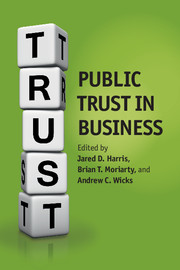Book contents
- Frontmatter
- Contents
- List of figures
- List of tables
- Notes on contributors
- Preface: discovering new territory in public trust in business
- Acknowledgments
- 1 Public trust in business: what’s the problem and why does it matter?
- Part I Trusting the institution of business
- Part II Public trust and business organizations
- 7 Public trust and trust in particular firm–stakeholder interactions: a theoretical model and implications for management
- 8 Creating more trusting and trustworthy organizations: exploring the foundations and benefits of presumptive trust
- 9 Building trust through reputation management
- 10 Can trust flourish where institutionalized distrust reigns?
- 11 Roles of third parties in trust repair: lessons from high-tech alliances for public trust
- 12 The repair of public trust following controllable or uncontrollable organizational failures: a conceptual framework
- 13 Toward a better understanding of public trust in business
- Index
- References
7 - Public trust and trust in particular firm–stakeholder interactions: a theoretical model and implications for management
Published online by Cambridge University Press: 05 July 2014
- Frontmatter
- Contents
- List of figures
- List of tables
- Notes on contributors
- Preface: discovering new territory in public trust in business
- Acknowledgments
- 1 Public trust in business: what’s the problem and why does it matter?
- Part I Trusting the institution of business
- Part II Public trust and business organizations
- 7 Public trust and trust in particular firm–stakeholder interactions: a theoretical model and implications for management
- 8 Creating more trusting and trustworthy organizations: exploring the foundations and benefits of presumptive trust
- 9 Building trust through reputation management
- 10 Can trust flourish where institutionalized distrust reigns?
- 11 Roles of third parties in trust repair: lessons from high-tech alliances for public trust
- 12 The repair of public trust following controllable or uncontrollable organizational failures: a conceptual framework
- 13 Toward a better understanding of public trust in business
- Index
- References
Summary
Executive summary
The situation
Leaders need a better understanding of “public trust,” what factors influence it, and what that means for organizational action.
We understand a great deal about organizational trust, but research generally assumes that all parties view trust in organizations the same way. Stakeholder trust – or, an analysis of differential stakeholder approaches to trust – has been relatively unexplored, with a few notable exceptions.
Key questions
What role can stakeholder theory play in understanding public trust in the institution of business?
How do different stakeholders conceptualize organizational trust, and what impact do these differences have? What does a better understanding of stakeholder trust tell us about public trust in business?
New knowledge
Trust has at least two key components – trust that is based upon an assessment of integrity or goodwill and trust that is based on an assessment of competence. Competence-based trust may be a higher priority in certain stakeholder relationships, whereas in others goodwill-based trust may be more important. Recognizing and understanding which aspect of trust has priority in particular stakeholder relationships, and understanding how those stakeholders balance these two aspects of trust in their decisions, would be highly useful to business leaders.
Key lessons
At the individual level, trust in the institution of business and trust in a particular business are distinct concepts.
Stakeholder roles (e.g., customer, employee, investor) differ qualitatively and engender different areas of emphasis when it comes to organizational trust; this has an important bearing on trust in business as an institution.
- Type
- Chapter
- Information
- Public Trust in Business , pp. 179 - 202Publisher: Cambridge University PressPrint publication year: 2014
References
- 3
- Cited by



